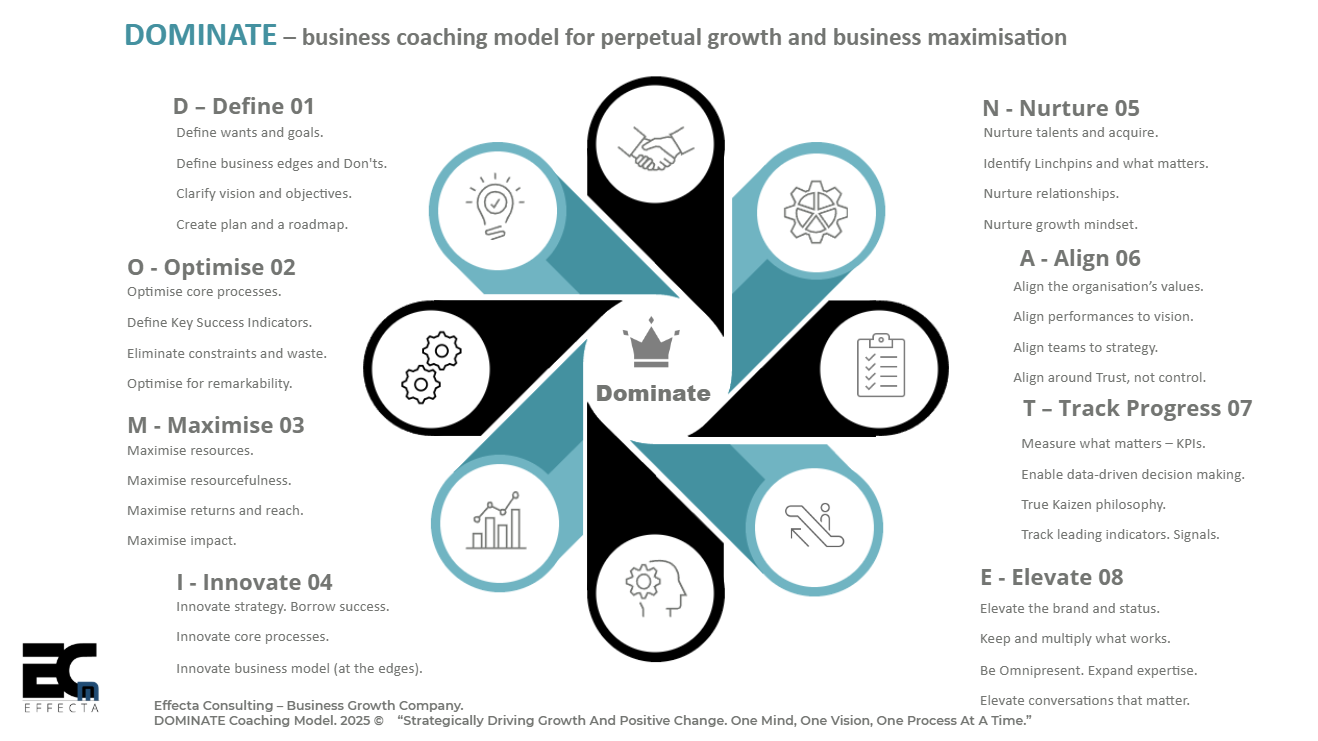Beyond Business Botox: DOMINATE Transforms Your Company’s DNA, Not Just Its Appearance
Most business models are mediocre. They’re designed by committee, watered down for mass consumption, and built to blend in rather than stand out.
DOMINATE isn’t for those businesses.
DOMINATE is for the few who understand that in today’s market, average is the same as invisible. It’s for leaders who recognise that following the crowd is the surest path to irrelevance.
“In a world of infinite noise, DOMINATE isn’t about shouting louder—it’s about saying something worth interrupting for. The businesses that truly dominate don’t win through force; they win through fascination.”
Let me break this down into something actionable instead of merely inspirational. Because the world doesn’t need another vague framework that sounds good in PowerPoint presentations but crumbles in practice.
D: Define Your Business Edges
Most businesses try to be everything to everyone. They sand down their edges until they’re completely smooth and utterly forgettable.
What would happen if you did the opposite?
Define the edges of your business—not just what you are, but what you’re not. Who you won’t serve? What you won’t do? This isn’t just about focus; it’s about creating tension that attracts the right people and naturally repels the wrong ones.
When Southwest Airlines decided they wouldn’t assign seats, wouldn’t serve meals, and wouldn’t use travel agents, they weren’t just cutting costs. They were defining edges that made them unmistakable.
Your homework: Write down ten things your business will never do, no matter how much money someone offers.
O: Optimise for Remarkability, Not Efficiency
The industrial mindset teaches us to optimise for efficiency. Make everything a little bit cheaper, a little bit faster.
But efficiency is a race to the bottom, and the bottom is crowded.
What if you optimised for remarkability instead? What if every process, every product, every customer interaction was designed not to be efficient, but to be worth remarking on?
Remarkability is exponential; efficiency is linear. A 10% improvement in efficiency might save you money. A product that’s 10% more remarkable might double your word-of-mouth marketing.
Your homework: Identify one aspect of your business that customers currently find merely satisfactory. How could you transform it into something they’d tell their friends about?
M: Model to Maximise Impact, Not Revenue
Revenue is a lagging indicator of impact. Focusing on revenue is like trying to drive by looking in the rearview mirror.
Instead, build models that maximise impact—solving real problems for real people in ways that matter. Revenue follows impact, not the other way around.
Amazon didn’t become Amazon by maximising quarterly returns. They built models that maximised customer experience, even when Wall Street analysts sneered.
Your homework: What’s the most significant impact your business could have on your customers’ lives? How would you restructure your operations if that impact was your only metric?

I: Innovate at the Edges, Not the Centre
Most innovation efforts focus on the center of the business—making the core product incrementally better. That’s not innovation; it’s maintenance.
Real innovation happens at the edges—exploring adjacent possibilities where others aren’t looking.
Netflix didn’t just make video rentals slightly better. They moved to the edge (DVD-by-mail), then another edge (streaming), then another (original content).
“The paradox of business transformation is that to DOMINATE your market, you must first abandon your obsession with domination. Focus instead on becoming the only logical choice for a specific few, not the tolerable compromise for the undiscerning many.”
Your homework: What are three edge areas where your business could explore? Not incremental improvements, but genuine paradigm shifts that could create entirely new categories.
N: Nurture Linchpins, Not Just Teams
Traditional management focuses on building teams. But teams without linchpins—those indispensable individuals who bring art, creativity, and emotional labour to their work—are just collections of interchangeable parts.
Nurture the linchpins in your organisation. Give them the autonomy, resources, and recognition they need to do work that matters.
Your homework: Who are the linchpins in your business? What would happen if you invested disproportionately in their growth and gave them permission to break the rules?
A: Align Around Trust, Not Control
Most businesses are built on control systems—policies, procedures, approvals. These systems assume people can’t be trusted, so they must be controlled.
What if you flipped this assumption? What if you built systems based on trust instead?
When you optimise for trust, you create organisations that move faster, innovate more readily, and attract better talent.
Your homework: Identify three control mechanisms in your business that could be replaced with trust-based alternatives. What’s the worst that could happen if you made this change tomorrow?
T: Track Leading Indicators, Not Just Results
Traditional businesses obsess over lagging indicators—sales, profits, market share. By the time these metrics change, it’s too late to do anything about it.
Leading indicators tell you what’s about to happen, not what already has. Customer engagement, sentiment, and early adoption patterns—these are the signals that matter.
“Most businesses are built to survive disruption. Exceptional businesses—those that DOMINATE—are built to cause it. They don’t react to the future; they author it, leaving competitors the unenviable task of explaining why they didn’t see it coming.”
Your homework: What are five leading indicators that would give you early warning of changes in your business’s trajectory? How could you start tracking them weekly?
E: Elevate Conversations, Not Just Performance
Most businesses try to elevate performance through incentives, targets, and reviews. But remarkable performance doesn’t come from managing performance; it comes from elevating the level of conversations in your organisation.
When people talk about bigger ideas, deeper principles, and more meaningful questions, their work naturally rises to meet the level of their thinking.
Your homework: What’s one conversation your business needs to have that it’s currently avoiding? How could you create the space for that conversation to happen authentically?
The DOMINATE Challenge
The DOMINATE model isn’t a silver bullet. It’s a challenge—a dare to build a business that matters instead of one that merely exists.
Most businesses won’t accept this challenge. They’ll continue optimising for efficiency, focusing on control, and measuring the wrong things. They’ll continue to be unremarkable.
But for the few who embrace this challenge, the rewards are extraordinary. Not just financial success, but the deeper satisfaction of building something worth talking about, something that changes the people it touches.
The market doesn’t need another average business. It needs businesses that DOMINATE—not through power or size, but through remarkability, trust, and impact.
The question isn’t whether you can afford to embrace this model. The question is whether you can afford not to.


2 Comments
Its such as you read my thoughts! You seem to know so much approximately this, such as you
wrote the ebook in it or something. I feel that you just could do with a few %
to power the message house a bit, but instead of that, this is magnificent blog.
A great read. I will certainly be back.
my homepage how to invisible ink iphone
I pay a visit daily a few websites and sites to read articles, except this web site provides quality based posts.